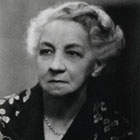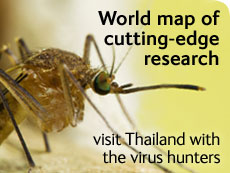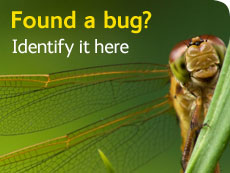Evelyn Cheesman
Whether skinning lizards, battling with leeches, or getting trapped in giant spider webs, Evelyn Cheesman had a passion for nature and a sense of adventure to match.

Evelyn Cheesman (1881-1969).
Evelyn was not daunted by Pacific Ocean expeditions even though they were considered hazardous for European women at the time. Her interest and research into the native, or endemic, fauna of the New Guinea region made her one of the key figures in entomology (the study of insects) in the 20th century.
The 70,000 specimens she collected have ensured her place as a collecting founder of the Natural History Museum.
Video
In this video Museum curator Jan Beccaloni describes Cheesman as a real pioneer. She was the first woman to be given a job at London Zoo and the first to travel on her own to remote regions of the South Pacific. Find out about Cheesman’s inspiring legacy, and how she refused to let bureaucracy stand in the way of her dreams.
For a more detailed look at her life read the Work and Timeline sections. Find out why she couldn’t pursue her original career choice and why this loss was our gain.
You need Adobe Flash Player, or an HTML5 enabled web browser, and JavaScript enabled to watch this video.
Visit the Adobe website to download the latest Adobe Flash Player
Work
Childhood love of nature
Raised in rural Kent, Evelyn’s early expeditions involved catching crickets and frogs. This was not a popular pastime with her nurse, who often found odd things in her pockets.
Rivalry with her siblings gave Evelyn a strong sense of daring and she was no stranger to facing fears head on.
She wanted to become a veterinary surgeon, but funds were limited as Evelyn’s brother Robert, later an eminent ornithologist, also had to be educated. The law was another obstacle. In 1906 the Royal Veterinary Society didn’t admit women.
Evelyn was sponsored by a friend to train as a canine nurse instead.
Insect curation
When World War 1 started, and war work was introduced, Evelyn used her fluency in German to help unmask British companies that were friendly to the Germans. During her lunch hour, she often relaxed in the relative tranquillity of the Natural History Museum.
In 1920, Evelyn became the first female Insect House Curator at the London Zoological Society.
The Insect House was almost empty but this didn’t cause much concern as plant displays were shown instead. Evelyn acquired a new stock of insects using a billy-can and net, and children near and far made contributions. More exotic species were donated by Covent Garden fruiterers, surprised by spiders lurking in their bananas.
Filled with newly bred butterflies and native British fauna, the Insect House was a success. When the Royal Veterinary Society began admitting women, Evelyn was no longer interested.
Skinning lizards and mounting mosquitoes
After studying entomology (insects) at the Royal College of Science, which later became Imperial College, Evelyn went on her first expedition. This was to the Galapagos Islands, from 1923-1925.
She learned some useful new skills including skinning lizards and birds, and mounting mosquito samples all aboard a rolling ship.
Evelyn was such a keen collector that when she was faced by an angry viper, panic was replaced by very, very slow collection plans. Another time, she spent hours trapped in the folds of a giant spider web.
Exploring on a budget
Evelyn led numerous expeditions throughout the 1920s and 30s to islands such as New Guinea, to find out whether the flora was native or if it had been brought to the islands from Australia. She was partly funded by the Natural History Museum.
Her budget for 12 months in the New Hebrides (1928-1930) was £300, covering return fares via Australia, hire of native carriers, food, and mailing of specimens. In fact, the money was enough to pay for 2 years of research.
As she offered such good value for money, most of her grant requests were approved. Her income was also supplemented by the publication of her books. Evelyn published 16 books before her death.
Working with indigenous people
Evelyn quickly learned to discount views that all indigenous people were aggressive and stupid and to ignore warnings about the ‘bad hats’ in the area.
The Archbishop of Canterbury and the High Commissioner of the New Hebrides (G.A. Joy) had doubts of a white woman's safety. But Evelyn was willing to integrate herself into native communities and so she had excellent relations with villagers. Their local knowledge of trails and hazards was invaluable.
The villagers saw Evelyn as protection against evil spirits and were also fascinated by her collecting kit of a pocket lens and moth-collecting screen.
Gifts from a king
Cannibal tribes such as the Big Nambas proved less fearsome than rumour suggested and Evelyn received gifts for King George V from Ringapat, the cannibal king. These gifts were backed by a vow from Ringapat against cannibalism. In 1930 they were presented to the King.
The gifts included a 4.25m (14ft) decorated spear and a necklace of hand-carved beads, which are now held by the British Museum.
Evelyn was known by the indigenous people as The Woman Who Walks. She didn’t use a sedan chair, as was the custom for white women in New Guinea, but a settler’s nervous wife insisted she should be accompanied everywhere by a native policeman.
Working conditions
Conditions were another constant problem, as Evelyn battled with fever, septic sores from leeches, recurring malaria, and being lamed for a week after a surprised bird-eating spider dropped a rock on her ankle.
The weather was often ‘absolutely vile’ and Evelyn had to sit or sleep on specimens to keep them dry. Officials were often incompetent and a year’s carefully-packaged specimens were ruined by rats. However, it was the leech in her teapot during a trip to the Cyclops Mountains in New Guinea that Evelyn considered the absolute limit.
Sharing knowledge
Evelyn returned by cargo boat to Britain, staying for the duration of World War 2. After a year of war work in Liverpool, she returned to London during the Battle of Britain. Further war work included the censorship board, plane-spotting and, finally, working as a lecturer to troops.
Telling stories of areas she had personally travelled in, illustrated by her own glass slide collection, Evelyn’s lectures proved enjoyable for speaker and audience alike. Also, her thorough knowledge of New Guinea was invaluable to the allied governments.
Evelyn’s last collecting trip was to Aneityum Island, near Fiji, in 1954, at the age of 73. On her return to England she continued researching taxonomy, the way living things are classified, and continued to publish both scientific papers and popular works.
The last of Evelyn’s 16 books was published in 1965, 4 years before her death at the age of 80.
Legacy
In the period from 1924-1952, Evelyn gave over 70,000 specimens to the collections of the Natural History Museum. Many of them were new to the Museum and a few were new to science.
Evelyn was made an Honorary Associate of the Department of Entomology in 1948 by the Board of Trustees. In 1955 she was awarded an OBE for her contribution to science.
Timeline
| 1881 | Evelyn Cheesman was born |
|---|---|
| 1881 | Natural History Museum opens at South Kensington |
| 1881-96 | Childhood in Westwall |
| 1896-1904 | Went to school in Ashford then worked as a governess in the Midlands |
| 1898 | Radium discovered by Marie and Pierre Curie |
| 1903 | First powered flight by the Wright brothers |
| 1904-05 | Work as a governess in Germany |
| 1911 | International Women's Day celebrated for the first time |
| 1912 | Trained as a canine nurse |
| 1915 | Father dies, mother moves in with Evelyn, and Evelyn enlists for war work |
| 1914-19 | World War 1 |
| 1919 | Sex Disqualification Act changed to allow women to train as vets, lawyers, and civil servants |
| 1919 | Made a fellow of the Royal Entomological Society |
| 1920 | Becomes first female Insect House curator |
| 1923 | Asked to join the St. George expedition to the Galapagos Islands |
| 1924 | Collecting in Marquesas Islands and the Tuamotu Atolls |
| 1925 | Expedition to the Society Islands |
| 1925 | Hitler's Mein Kampf published |
| 1928-30 | Expedition to the New Hebrides |
| 1928 | All British women over the age of 21 gain the right to vote |
| Undated | Expedition to Aneityum Island |
| 1933-34 | First book published, Backwaters of the Savage South Seas |
| 1935-36 | Expedition to the Cyclops Mountains |
| 1939-45 | World War 2 |
| 1945-50 | Expeditions to New Caledonia |
| 1948 | Made Honorary Associate of the Natural History Museum's Department of Entomology |
| 1953 | Hip replacement operation makes further expeditions possible |
| 1953 | Queen Elizabeth II succeeds the throne |
| 1954-55 | Final collecting trip to Aneityum Island |
| 1955 | Awarded an OBE |
| 1965 | Publishes 16th and final book, Who stand alone |
| 1969 | Evelyn dies, aged 80 |

